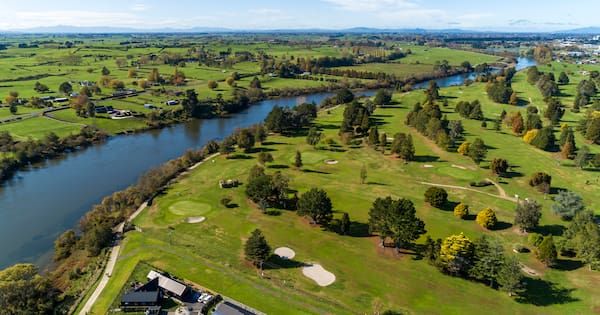Arsenic levels in Waikato River within 'usual range', councils say

Results of Waikato River water testing between Lake Ōhakuri and Rangiriri show arsenic levels are "within the normal range expected".
On Wednesday, both Auckland's Watercare and the Hamilton City Council reported "elevated levels" of arsenic had been detected at two treatment facilities that drew water from the Waikato River. Yesterday, Waipā and Waikato district councils reported "slightly elevated" levels of arsenic.
A joint statement from the affected councils and other organisations said that samples taken directly from the Waikato River showed arsenic levels were between 0.0189 mg/litre and 0.0256 mg/litre. The maximum accepted value for arsenic in treated water is 0.01mg/L.
The same sites were usually between 0.0123 mg/litre and 0.03 mg/litre.
"In all cases, drinking water remains safe to drink, with arsenic levels now also meeting Drinking Water Standards for Watercare and Waikato District Council," the statement said.
It also said the current levels of arsenic do not affect recreational activities like swimming.
Waikato Regional Council environmental science manager Mike Scarsbrook said arsenic levels were within the "normal long-term range".
“While the levels are within the range of normal for the Waikato River, there has been a small increase in the amount of dissolved arsenic in the water. This can be harder for treatment plants to remove, but the change is so small we don’t believe it’s the main cause of the current situation.
“We think it’s more likely to be a change to an alternative chemical form of arsenic, which is known to be more difficult to remove by treatment plants. This change is possibly caused by changes in temperature, dissolved oxygen and pH within the hydro lakes. We’ve seen a similar situation in 2012 and 2013, which resolved itself."
The statement said the elevated levels were likely the result of three main causes, being geothermal sources of arsenic from Lake Taupō, geothermal sources of arsenic in the upper Waikato River around Wairakei and Ohaaki, and accumulated arsenic in sediments within the hydro lakes along the Waikato River.
Water Services Authority — Taumata Arowai head of operations, Steve Taylor, said the authority was continuing to monitor the situation and ensure suppliers were taking appropriate steps.
“The drinking water suppliers are working to find out what has happened so they can to optimise their treatment processes to reduce arsenic levels to below the MAV," he said.
“We are also working closely with the Waikato Regional Council to understand fully how the changes in arsenic composition are affecting water treatment processes.”
National Public Health Service regional clinical director Dr William Rainger urged people not to be alarmed.
“Drinking water with slightly elevated levels for a short period of time is unlikely to impact people’s health.
“You do not need to boil your drinking water. It is safe to drink.”
New Zealand Food Safety’s deputy director general Vincent Arbuckle said the current levels were not harmful for animals and that there was no evidence water used for animals or food production was unsafe.
"If there was a risk to food safety, we would take appropriate action to protect consumers, including recalls.”
Tests show a 'small reduction' in Waipā
According to the Waipā District Council, the water was still safe to use, with results from today showing a "small reduction" in arsenic levels.
The council recorded 0.0128 and 0.0131 mg/litre from its two main treatment plants, down from 0.0129 and 0.0143 yesterday.
Water services manager Karl Pavlovich said the council had added the Alpha Street treatment plant to its testing regime. This afternoon, the plant's results were 0.0125mg/litre, down from 0.0126 yesterday.
“We will continue to test daily,” Pavlovich said. “The water remains safe for drinking, bathing, and cleaning, and there is no need for people to boil it.”
Levels under maximum acceptable values in Waikato
According to the Waikato District Council, levels from its treatment plants had returned to being under Drinking Water Standards' maximum acceptable values.
Treated water being supplied from Ngaaruawaahia, Huntly, and Te Kauwhata plants was below 0.01mg/litre. Results from Watercare’s treatment plant that supplies Pookeno and Tuakau were also below 0.01mg/litre.
"Watercare Waikato will continue to test daily to ensure any fluctuation of arsenic levels are captured."
Arsenic levels in Hamilton remain 'slightly elevated'
According to the Hamilton City Council, test results found levels remained "slightly elevated", but work to bring them down was continuing.
“The levels are not yet within the relevant Drinking Water Standard, but our water supply remains safe for everyday use,” unit director Three Waters Maire Porter said.
“Making changes to a complex process is not something you want to rush, but we’re making incremental changes with the aim of bringing the levels back down in coming days.”
Porter said a number of approaches were being planned to bring down levels across the weekend and early next week.
"Staff at the city’s water treatment plant are optimising existing arsenic removal processes, and a new membrane filtration system, which treats the water in a different way, will be brought online.
"In conjunction with industry experts, Council’s specialists are looking at chemical changes to the arsenic during treatment to enable existing systems to remove it more easily.
“We anticipate seeing positive results as we make these changes and will continue to work with the water regulator, neighbouring councils and industry experts.”
Auckland's water is within standards for three days running
Watercare chief operations officer Mark Bourne said results in Auckland had met standards for three days running.
“We continue to be cautiously optimistic and are continuing our daily sampling programme for the time being.
“Water produced at our Waikato Water Treatment Plant passes through a robust multi-barrier treatment process that includes coagulation, clarification, filtration and absorption processes.
“This treatment process is effective in eliminating a wide range of contaminants, including microorganisms, ensuring safe drinking water.”















































